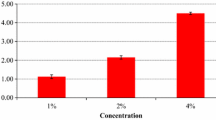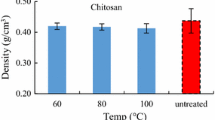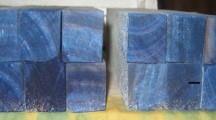Abstract
Effects of nano-chitosan on physical and mechanical properties as well as bio-resistances of beech and fir wood were investigated in the current research work. nano-chitosan was prepared and used to treat wood due its smaller size and also stability of the solution. Beech and fir wood blocks were treated with chitosan and nano-chitosan as 1 % concentrations to determine their physical and mechanical properties as well as resistance against white and brown rot fungi. Scanning electron microscope (SEM) as well as zeta meter was also applied to measure the nano-chitosan. SEM and zeta meter studies showed that the nano-chitosan particles were in very smaller sizes having an average value of 39 nm. Also, the solution was stable with no deposition after 30 days. It was also revealed that the treated fir wood enhanced dimensional stability of about 40 % after soaking in water for 24 h. Mechanical properties of the treated woods were not affected due to treatment. Also, the treated sample showed no resistance against both rotting fungi. It means that the nano-chitosan do not protect wood against decaying fungi. However, it can affect physical properties with no reduction in the mechanical properties.










Similar content being viewed by others
References
American Society for Testing and Materials, ASTM D143-94. Testing small clear timber specimens
American Society for Testing and Materials, ASTM D256. Standard test methods for determining impact resistance of plastics
American Society for Testing and Materials, ASTM D2395-02. Standard test methods for specific gravity of wood and wood-based materials
Bravery AF (1978) A miniaturized wood block test for the rapid evaluation of wood preservative fungicides. Document No IRG 2113
De Moura MR, Aouada FA, Mattoso LHC (2008) Preparation of chitosan nano particles using methacrylic acid. Coll Interf Sci 321:477–483
Enescu D (2008) Use of chitosan in surface modification of textile materials. J Roum Bio technol Lett 13(6):4037–4048
Kumar MNVR (2000) A review of chitin and chitosan applications. React Funct Polym 46(1):1–27
Larnøy E, Eikenes M, Militz H (2005) Uptake of chitosan based impregnation solutions with varying viscosities in four different European wood species. Holz Roh Werkst 63:456–462
Linden J, Stoner R, Gardner HC (2000) Organic disease control elicitors. Agro Food Ind 20:12–15
Mima S, Miya M, Iwamoto R, Yoshikawa S (1983) Highly deacetylated chitosan and its properties. Appl Polym Sci 28:1909–1917
Muzzarelli RAA, Tomasetti M, Ilari P (1995) Depolymerization of chitosan and substituted chitosans with the aid of a wheat-germ lipas preparation. Enzy Micro Technol 17:541–545
Sanford PA (1989) Commercial uses and potential applications. In: Skjak-Braek G, Anthonsen T, Sanford PA (eds) Chitin and Chitosan. Elsevier, New York, pp 51–70
Senel S, McClure SJ (2004) Potential applications of chitosan in veterinary medicine. Adv Drug Deliv Rev 56:1467–1480
Shahidi F, Arachchi JKV, Jeon YJ (1999) Food application of chitin and chitosan. Trends Food Sci Technol 10:37–51
Stössel P, Leuba JL (1984) Effect of chitosan, chitin, and some amino sugars on growth of various soil borne phytopathogenetic fungi. Phytopathology 111(1):82–90
Sudeshna S, Kocaefe D, Sarkar DK, Boluk Y, Pichette A (2011) Effect of TiO2 containing nano-coatings on the color protection of heat-treated jack pine. Coat Technol Res 8(2):183–190
Taghiyari HR (2010) Study on the effect of nano silver impregnation on mechanical properties of heat-treated Populusnigra. Wood Sci Technol 45:399–404
Treu A, Larnøy E (2007) Chitosan Treated Wood and its Effectiveness Against Soft Rot. Proceedings of the 3rd Meeting of the Nordic-Baltic Network in Wood Material Science and Engineering (WSE), Helsinki, 12: 27–32, 29–30 October 2007
Witt B, Treu A (2009) Synergistic Effects between Chitosan and Different Wood Protection Agents.Proceedings of the 6th meeting of the Nordic-Baltic Network in Wood Material Science and Engineering (WSE), Copenhage, 32: 133–141, 21–22 October 2009
Author information
Authors and Affiliations
Corresponding author
Rights and permissions
About this article
Cite this article
Nowrouzi, Z., Mohebby, B. & Younesi, H. Influences of nano-chitosan treatment on physical, mechanical properties and bio resistance of wood. J Indian Acad Wood Sci 11, 174–181 (2014). https://doi.org/10.1007/s13196-014-0134-y
Received:
Accepted:
Published:
Issue Date:
DOI: https://doi.org/10.1007/s13196-014-0134-y




